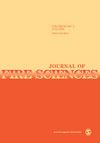定向刨花板热解模型的发展:第二部分-热传递参数化和实验规模验证
IF 1.9
4区 工程技术
Q2 ENGINEERING, MULTIDISCIPLINARY
引用次数: 5
摘要
定向刨花板是一种广泛使用的建筑材料,承担了许多建筑物的很大一部分火灾负荷。为了准确地模拟面向刨花板的火灾反应,本研究的第一部分使用毫克级测试仔细表征了其热分解和燃烧的动力学和热力学。在当前的工作中,受控气氛热解装置II在一定范围的辐射热通量下对具有代表性的克级定向板样品进行了测试。对这些测试中获得的样品温度数据进行自动反分析,以确定未分解的定向刨花板及其分解后的冷凝相产物的导热系数。建立了该材料的完整热解模型,并用于预测可控气氛热解装置II实验中测量的质量损失率。除了在辐射热流密度为65 kW m−2时观测到的第二个质量损失率峰值被低估外,这些质量损失率曲线都得到了很好的预测。为了进一步验证该模型,在定向刨花板上进行了辐射热通量为25和50 kW m - 2的锥形量热仪测试。这些试验的结果,包括质量损失率和放热率分布,都可以通过模型很好地预测。本文章由计算机程序翻译,如有差异,请以英文原文为准。
Development of a pyrolysis model for oriented strand board: Part II—Thermal transport parameterization and bench-scale validation
Oriented strand board is a widely used construction material responsible for a substantial portion of the fire load of many buildings. To accurately model oriented strand board fire response, kinetics and thermodynamics of its thermal decomposition and combustion were carefully characterized using milligram-scale testing in part I of this study. In the current work, Controlled Atmosphere Pyrolysis Apparatus II tests were performed on representative gram-sized oriented strand board samples at a range of radiant heat fluxes. An automated inverse analysis of the sample temperature data obtained in these tests was employed to determine the thermal conductivities of the undecomposed oriented strand board and condensed-phase products of its decomposition. A complete pyrolysis model was formulated for this material and used to predict the mass loss rates measured in the Controlled Atmosphere Pyrolysis Apparatus II experiments. These mass loss rate profiles were predicted well with the exception of the second mass loss rate peak observed at 65 kW m−2 of radiant heat flux, which was underpredicted. To further validate the model, cone calorimeter tests were performed on oriented strand board at 25 and 50 kW m−2 of radiant heat flux. The results of these tests, including both mass loss rate and heat release rate profiles, were predicted reasonably well by the model.
求助全文
通过发布文献求助,成功后即可免费获取论文全文。
去求助
来源期刊

Journal of Fire Sciences
工程技术-材料科学:综合
CiteScore
4.00
自引率
0.00%
发文量
14
审稿时长
2.5 months
期刊介绍:
The Journal of Fire Sciences is a leading journal for the reporting of significant fundamental and applied research that brings understanding of fire chemistry and fire physics to fire safety. Its content is aimed toward the prevention and mitigation of the adverse effects of fires involving combustible materials, as well as development of new tools to better address fire safety needs. The Journal of Fire Sciences covers experimental or theoretical studies of fire initiation and growth, flame retardant chemistry, fire physics relative to material behavior, fire containment, fire threat to people and the environment and fire safety engineering. This journal is a member of the Committee on Publication Ethics (COPE).
 求助内容:
求助内容: 应助结果提醒方式:
应助结果提醒方式:


